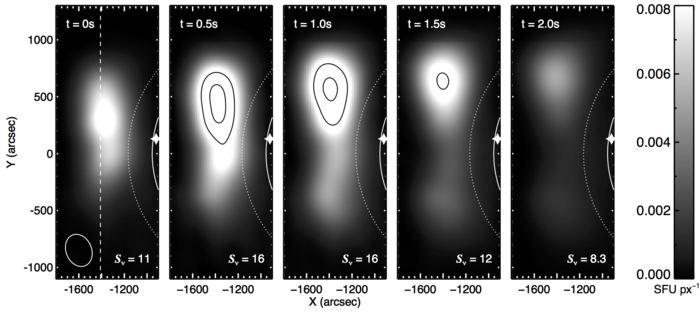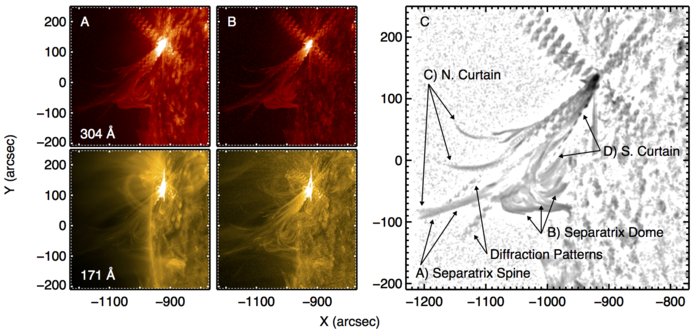Unusual Type III Burst Dynamics Produced by Diverging Magnetic Fields
From RHESSI Wiki
| Nugget | |
|---|---|
| Number: | 311 |
| 1st Author: | Patrick McCauley |
| 2nd Author: | |
| Published: | 27 November 2017 |
| Next Nugget: | Tweeting |
| Previous Nugget: | Valderrama flare |
| List all | |
Contents |
Introduction
Type III solar radio bursts are widely believed to be caused by electron beams accelerated away from the Sun during solar flares. Fast electrons stimulate oscillations in the ambient plasma, which in turn produce radio emission. This plasma emission occurs at specific frequencies that are proportional to the square root of the ambient electron density. The plasma density in the solar corona generally decreases outwards from the solar surface. The emission frequency is therefore related to the height that corresponds to the requisite background density, and type III bursts are characterized by a rapid drift to lower frequencies as the beams move outward.
Source Region Splitting
A series of type III bursts have recently been observed to exhibit a curious splitting behavior by the Murchison Widefield Array (MWA), a new and very powerful low-frequency radio interferometer (Ref. [1]). In these bursts the source region splits from one component at higher frequencies (smaller heights), into two increasingly-separated components at lower frequencies (larger heights). The two components also repetitively move apart at a few tenths of light speed in observations at individual frequencies. This motion, shown in Figure 1, lasts around 2 seconds and occurs many times over several minutes.

Magnetic Field Configuration
Extreme ultraviolet (EUV) jets observed by the Solar Dynamics Observatory/AIA immediately follow the radio bursts. These thermal plasma ejections and the type III electron beams follow particular trajectories within the coronal magnetic field, and previous studies have demonstrated alignment between the two (e.g. Ref. [2]). The EUV jets trace out a region where the magnetic field diverges rapidly around a null point. This configuration is a type of quasi-separatrix layer (QSL), generally meaning a region where the field connectivity changes drastically within a small area. Several common features of null point QSLs are identified in Figure 2, which compiles all of the EUV jet trajectories into one persistence map.

References
[1] "Type III Solar Radio Burst Source Region Splitting Due to a Quasi-Separatrix Layer"
[2] "Tracing Electron Beams in the Sun's Corona with Radio Dynamic Imaging Spectroscopy"
| RHESSI Nugget Date | 27 November 2017 + |
| RHESSI Nugget First Author | Patrick McCauley + |
| RHESSI Nugget Index | 311 + |